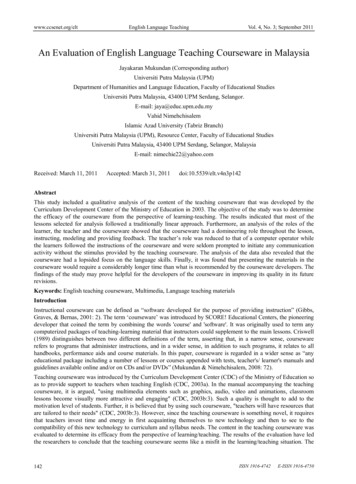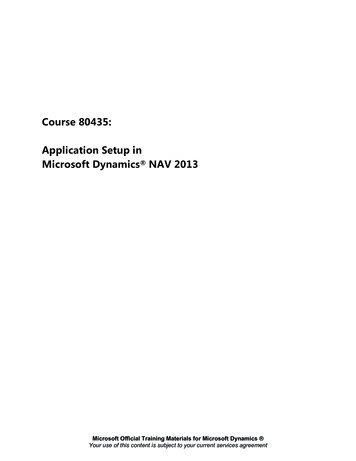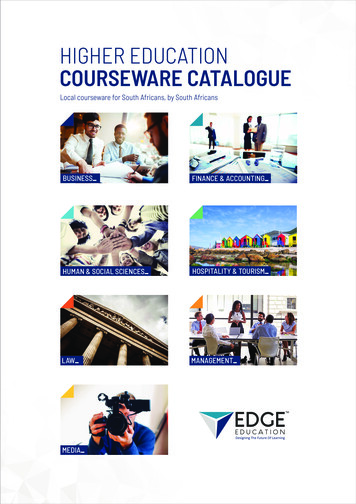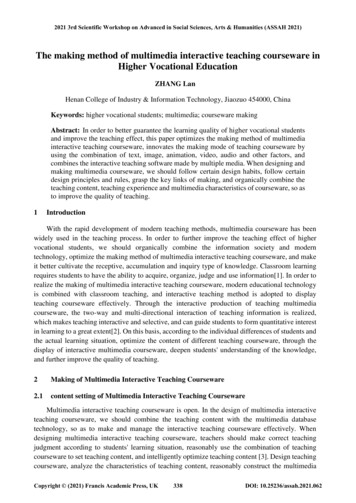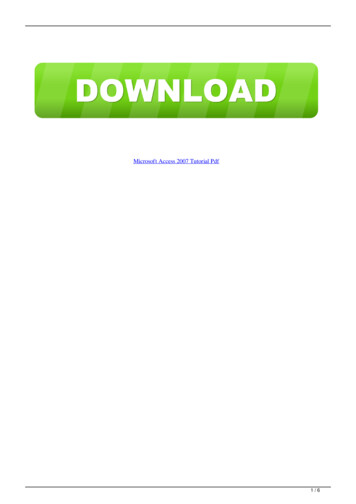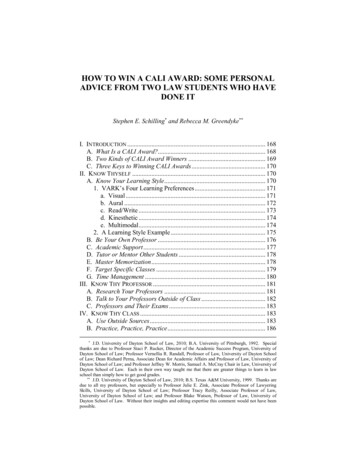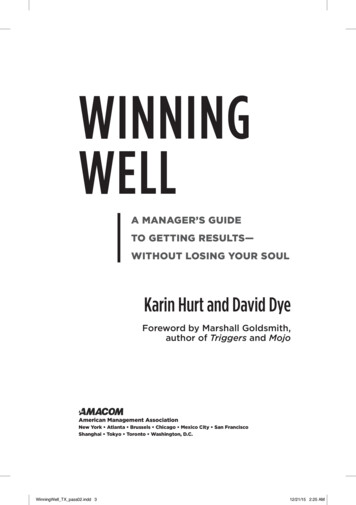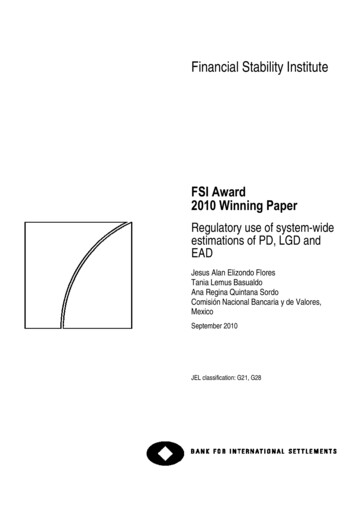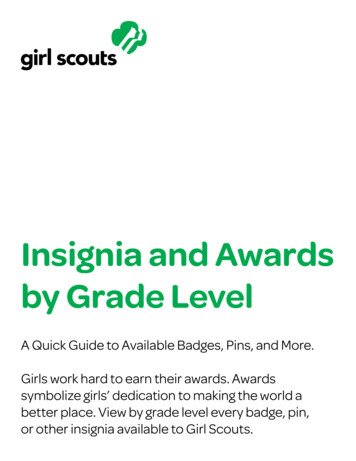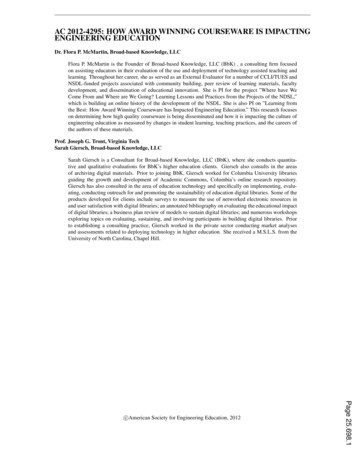
Transcription
AC 2012-4295: HOW AWARD WINNING COURSEWARE IS IMPACTINGENGINEERING EDUCATIONDr. Flora P. McMartin, Broad-based Knowledge, LLCFlora P. McMartin is the Founder of Broad-based Knowledge, LLC (BbK) , a consulting firm focusedon assisting educators in their evaluation of the use and deployment of technology assisted teaching andlearning. Throughout her career, she as served as an External Evaluator for a number of CCLI/TUES andNSDL-funded projects associated with community building, peer review of learning materials, facultydevelopment, and dissemination of educational innovation. She is PI for the project ”Where have WeCome From and Where are We Going? Learning Lessons and Practices from the Projects of the NDSL,”which is building an online history of the development of the NSDL. She is also PI on ”Learning fromthe Best: How Award Winning Courseware has Impacted Engineering Education.” This research focuseson determining how high quality courseware is being disseminated and how it is impacting the culture ofengineering education as measured by changes in student learning, teaching practices, and the careers ofthe authors of these materials.Prof. Joseph G. Tront, Virginia TechSarah Giersch, Broad-based Knowledge, LLCSarah Giersch is a Consultant for Broad-based Knowledge, LLC (BbK), where she conducts quantitative and qualitative evaluations for BbK’s higher education clients. Giersch also consults in the areasof archiving digital materials. Prior to joining BbK, Giersch worked for Columbia University librariesguiding the growth and development of Academic Commons, Columbia’s online research repository.Giersch has also consulted in the area of education technology and specifically on implementing, evaluating, conducting outreach for and promoting the sustainability of education digital libraries. Some of theproducts developed for clients include surveys to measure the use of networked electronic resources inand user satisfaction with digital libraries; an annotated bibliography on evaluating the educational impactof digital libraries; a business plan review of models to sustain digital libraries; and numerous workshopsexploring topics on evaluating, sustaining, and involving participants in building digital libraries. Priorto establishing a consulting practice, Giersch worked in the private sector conducting market analysesand assessments related to deploying technology in higher education. She received a M.S.L.S. from theUniversity of North Carolina, Chapel Hill.Page 25.698.1c American Society for Engineering Education, 2012
How Award Winning Courseware is Impacting Engineering EducationAbstractIn this paper, we report on a study regarding the impact of the Premier Award for Excellence inEngineering Education Courseware. This paper describes the first two phases of the research andfindings with implications for engineering education. Research questions focus on, identifyingthe impact of the award on the courseware authors and developers, their teaching and theirstudents’ learning; gathering information on the evolution of the award itself; and, describing thespread of pedagogical innovations across engineering and other related disciplines.The interviews and content analysis to date have initiated a rich description of the impact on theawardees' careers, especially with regard to their teaching practices and STEM educationscholarship. It appears that the Premier Award holds some prestige and has been instrumental inshaping the careers of graduate students and young faculty members. Analysis of the awardees’dossiers revealed the challenges associated with evaluating the impact of innovations on teachingand learning as well as issues surrounding the dissemination of innovations in engineeringeducation.Page 25.698.21. IntroductionIn this paper we report on preliminary results of a study undertaken to determine the impact ofthe Premier Award for Excellence in Engineering Education Courseware on the culture ofengineering education. NEEDS, the precursor to the Engineering /index.jhtml) developed the Premier Award “torecognize high-quality, non-commercialFigure 1: Courseware Definedcourseware designed to enhance14“Engineeringcourseware is computer-basedengineering education.” One of the aimseducational material that can be used to assistof establishing and promoting the awardwas to provide faculty members who create engineering students in their learning process .Courseware can be used in lectures, duringinnovative online teaching materialsrecitation sections, as self-paced study, asrewards and recognition for their efforts.reference material for the student, or asThe award was an effort to initiate anappreciation for this work with the intent of exercises for the student to perform alone or ina group. Typically, courseware takes advantageultimately shifting the engineeringof multiple media, such as graphics,educational environment from one that didphotographic images, sound, video andnot appear to support or reward the effortsanimation to illustrate engineering concepts,of these faculty members to one that did.devices, or practices. Courseware will ofteninclude features such as hyperlinks or hypertextWhen this research was initiated in 2010,which permit users to explore relatedthe program had run for 14 years, and theinformation or greater depth of information asPremier Award Review Committee hadthey are interested.”6, 7reviewed over 120 courseware submissionsand selected 22 award winners and twofinalist candidates. Premier Award winning materials have historically been the most frequentlydownloaded materials on the NEEDS/Engineering Pathway website, and over 40,000 PremierAward CDs have been distributed in the engineering education community. Multiple workshopsand seminars about Premier Award courseware have been presented to engineering educators.
Study of the type of cultural and environmental shifts envisioned by the award’s developersrequires that the program have a fairly long timespan and the kind of sustained disseminationefforts described above in order to observe and describe change or impact on a particular cultureor environment. The research team determined that a qualitative research approach was the mosteffective means to gaining insight into the factors that might affect change in an engineeringeducation, particularly those that might indicate a shift in appreciation of innovations involvingtechnology, teaching and student learning. The research questions guiding the study are:1. How has receipt of the Premier Award impacted the awardees’ career paths and why?2. How has the quality of the courseware submitted changed over time?3. How has the award winning courseware affected student learning?4. What kinds of dissemination activities and mechanisms are successful in promotingsuccessful adoption and use of courseware?In this paper we report on the results in the first phases of the study (conducted during 2011),which addresses research questions one, two and four.1.1 Background of the Premier AwardThe Premier Award competition was instituted with two primary goals: to recognize and rewardthe efforts of faculty (and students) developing courseware and to provide an external measure ofthe quality of the courseware.14 The Premier Award was created as a program within theSynthesis Coalition, one of the NSF engineering education coalitions funded in the 1990’s,which focused on improving engineering education by designing, implementing and assessingapproaches to undergraduate engineering education that emphasized multidisciplinary synthesis,teamwork and communication, hands-on and laboratory experiences, open-ended problemformulation and solving, and examples of "best practices" from industry.1 The SynthesisCoalition also initiated NEEDs the pioneering engineering education digital library ofengineering courseware and NEEDS continued to sponsor the award after the SynthesisCoalition funding ended. NEEDS has since been subsumed by the Engineering Pathway digitallibrary (http://www.engineeringpathway.com/ep/).The environment in higher education within which the Premier Award was implemented, was anengineering education culture where few faculty members were creating courseware materials,and the quality varied widely. Engineering education administrators, promotion and tenurecommittees, and faculty colleagues did not value nor know how to judge the value of theinnovative courseware created or authored by these innovative faculty members.5, 12 The facultymembers who made up the NEEDS community however, envisioned a future where computerbased, electronic teaching and learning materials would play a much more central role inengineering education8, 11, 16 so, judging the quality of courseware would become an essentialpractice of faculty who would use these materials. As part of the development of the PremierAward, peer review criteria that could be used both in the judging process for the award and laterby faculty members in general, were created.6Page 25.698.3The award then, would serve to educate others about the qualities and aspects of courseware thatmade them ‘good’ as well as to promote excellence by awarding that courseware that met orsurpassed the criteria. The goal of raising the visibility of the award and awardees by presenting
the award in a highly publicized manner and broadly promoting the award winning coursewarewas to make engineering educators more aware of the truly innovative and high quality work ofcourseware developers and thereby establish this type of work as a valued part of academe andthe scholarship of teaching and learning.In short, the designers of the Premier Award saw it as a way to provide much needed recognitionto these pioneering educators, disseminate models of high quality courseware as a way toencourage more innovation and development, and interest textbook publishers in digital learningmaterials. They also believed that in the long run, the Premier Award would demonstrate that useof courseware would have a positive impact on student learning, that it would improve teachingpractices of engineering educators, which would result in changes in promotion and tenurecriteria to value courseware development.1.2 Teaching AwardsAt the outset of this project, we re-read articles written early in the history of the Premier Awardto remind ourselves of the context in which the Award was created. While the articles (Eibeck’swork6 and Muramtsu’s12 work are prime exemplars) discussed in detail the evaluation criteria andprocesses, they did not situate the Premier Award within the continuum of faculty incentives orrewards within the engineering discipline or within higher education. As a result, we attemptedto identify sources that discussed the role or impact of awards on faculty careers (includingpromotion and tenure); that provided a comprehensive list of awards given by higher educationinstitutions; and that identified the role of awards in changing work culture within highereducation.A preponderance of the literature (i.e., approximately 3,700 citations from the ERIC database)associated with awards and faculty, concerns awards for teaching excellence, the majority ofwhich are conferred at the campus level. Much of literature, especially that during the timeframework in which the Premier Award was created, focuses on the role of such awards, how toimplement them, and how they were intended to impact a faculty member’s career. Few if anyarticles were research based, meaning little empirical research had been done on questionssimilar to those of this study. Much of the discussion is strongly related to the emergingScholarship of Teaching and Learning (SOTL) movement that began in the 1990’s. SOTLdiscussions center around how providing rewards might bring into the balance the rewardsystems for teaching and research that at that time, more heavily rewarded research, with facultymembers risking promotion and tenure should they chose to focus on teaching and learning.4Page 25.698.4Recent studies of the impact of these types of programs show decidedly mixed results suggestingthat promotion and tenure was and still is elusive, though not unattainable for those who chose tofocus on the scholarship of teaching and learning. 4, 17 These studies also point out the lack ofconsistency in terms of the criteria used for such review at the department and campus levels aswell as regional and national. 2, 3, 5, 17 Hattendorf-Westeney10 writing in 2000, an early stage ofthe Premier Award, provides some context for how novel it was to use information technology inthe classroom and for scholarly publishing, and how this affected faculty in the promotion andtenure process. The result was not positive – those faculty members who were using technologyfaced views of technology that were fairly benign, i.e., “simply a means for informationdelivery” to being recognized as a form of scholarship, depending upon the discipline.
Regardless, at that time, most faculty members reported believing that too much focus ontechnology and teaching would be detrimental to their careers.The Premier Award however, is an unusual award in that it is not focused on teaching per se, buton technology development, that is, the courseware itself. In this case, the focus is on the qualityof the learning materials not teaching, and one of the important criteria for the award is itspotential for use by other faculty members, not just the person who design and used it. We founda decidedly large gap in the literature (no results) when searching for awards associated withinthis type of category. When established this type of award was unique. It should be noted thatsince then, other digital libraries most notably, MERLOT (www.merlot.org), have institutedsimilar awards.2. Research MethodsThe research design of the study relies upon collecting and analyzing data from a variety ofsources including: content analysis of the dossiers submitted for the award (winners and nonwinners), interviews with the lead authors of the award winning dossiers, secondary authors, andcitation analysis of articles associated with the authors and developers. Glaser and Strauss’s9content analysis methods associated with theory building guide the content analysis.2.1 Citation and Dossier AnalysisFor the first phase of the research, we focused on addressing questions: how has receipt of thePremier Award impacted the awardees’ career paths and why? How has the quality of thecourseware submitted changed over time? And, what kinds of dissemination activities andmechanisms are successful in promoting successful adoption and use of courseware? Contentanalysis was conducted on primary source material, the dossiers submitted by award applicants,supplemented with secondary sources such as applicants’ teaching or personal websites andwebsites created specifically for the courseware.Since 1996, Premier AwardFigure 2: Outline of Dossier Contentsapplicants have prepared a dossier Descriptionof the impact of courseware;that includes a narrative (Figure Descriptionhow the courseware is used by2) and that addresses the PAlearners and include supporting materials;Evaluation Criteria (Appendix A). Description of activities used to assess studentFrom 1996 to 2010, 120 dossierslearning through use of the courseware;were submitted. From this group Statements of Reference from instructors22 award winners and two finalistother than the author(s);candidates were selected for Journal or conference papers describing theanalysis.courseware and its use; Evaluation instruments and results;Page 25.698.5The dossiers contain a trove of Supporting materials to assist the judges insemi-structured data that, whileevaluating the courseware.not always consistent in level ofdetail, provide a foundation foridentifying changes over time in such areas as: courseware development (i.e., pedagogical designand technology platforms); strategies used to disseminate innovations in engineering education;and, methods to assess courseware impact in the classroom.
2.1.1 Citation AnalysisOne of the first data collection activities for the project was gathering citations for an analysisthat would contribute to our understanding of how the courseware was disseminated and used byother instructors. The goal of this effort was to determine if applicants continued to publish abouttheir courseware after receiving the Premier Award and if those articles were further cited byother authors. Active and continued publication records by applicants would demonstratecontinued involvement in teaching innovation and scholarship as well as help determine howadopters found the courseware and learned how to use it.Beginning with citations listed in the dossiers of award-winners, we searched the ISI Web ofScience, a database that indexes over 8,300 major journals across 150 disciplines in the sciencesbeginning in 1900 and that indexes conference proceedings since 1990. Many of the journals inWeb of Science "count" for tenure and promotion. However, searches for applicant's names,article titles, and courseware name yielded zero results. By cross checking the ISI journals andconferences list, we determined that many publications about courseware are not indexed in ISIWeb of Science. That the publications were not catalogued in the ISI suggests that facultymembers’ perceptions about scholarship in this area not being recognized in promotion andtenure processes may be correct. This perception will require further checking with the nextround of interviews. Further citation analysis is in progress, with the citations being checked byhand; the goal being to create a complete record of publications/presentations that more clearlyoutlines dissemination paths and efforts.2.1.2 Content AnalysisIn conducting the in-depth analysis of the dossiers we examined a sample that included themajority of winning dossiers and a subset of non-winning dossiers. All 19 award-winners from1998-2010 were included in the sample. The three first-year awardees were eliminated from thereview since it was the first year of the award, still a pilot program and two of the winners sit onthe project's Advisory Board. The 2011 submissions were not analyzed because they were underreview by the judging committee at the time of the analysis.We included a subset of 10% of the non-winners to ensure that findings were indicative of thebroader field of engineering courseware applicants and to test the coding scheme for futurereview of all dossiers. To generate the sample of non-winners, we submitted an alphabetized listof the 100 author surnames to random.org, which put the names in a random sequence. We thentook the first 10 names. As a result, some years were not represented while other years includedtwo non-winning applicants. One possible reason for this is that some years had more applicantsthan others.Two researchers on our team divided the total pool of 29 dossiers and iteratively developed aPremier Award Dossier Codebook. Prior to coding all dossiers, both researchers read and codedone dossier to test the reliability of the coding and Codebook. Figure 3 shows the distribution ofdossiers in the sample.Page 25.698.6
Figure 3. Distribution of Analyzed Dossiers# of nner001998 1999 2000 2001 2002 2003 2004 2005 2006 2007 2008 2009 2010Years2.2 Interviews with AwardeesThe second phase of the research (currently ongoing) consists of conducting telephoneinterviews with award-winning applicants to examine the impact of the award on their careersand the impact of their dissemination efforts. To date we have conducted 14 interviews withdossier applicants, with one applicant declining to be interviewed. Interviews are semistructured, one-on-one conversations between a researcher and an applicant. The interviews areretrospective in nature and cover: the motivation for creating the courseware; efforts andstrategies used to disseminate or share it with others; success of dissemination efforts to date;and awardees’ impressions of the impact of the award on their careers and engineeringeducation. A major section of the interview consists of discussing the level to which receivingthe PA supports awardees’ teaching and educational research. The interviews are recorded andtranscribed, and coded using the coding software, NVIVO 9.2.3. Summary of Preliminary ResultsOur analysis has focused on learning about the awardees’ perceptions of the impact of the awardon their career paths, the kinds of dissemination activities they have undertaken and how thecourseware has changed over time. Though data collection and analysis are not yet completed,trends are emerging. In the following sections we expand on our understanding of these earlyresults.3.1 Impact of Receiving the Award on Academic Career PathsTo examine the impact of the award on careers, we focus on data from the interviews. Theparticipants in the interviews conducted to date represent a range of possible faculty career paths(Table 1). Several interviewees who received the Premier Award over a decade ago are nowretired, nearing retirement, or have assumed administrative leadership positions. Otherinterviewees are at an early- to mid-career stage because at the time of the award, they weregraduate students members of the development teams. Even as graduate students, they often ledthe development and research associated with the courseware.Page 25.698.7One emerging pattern reflects how the award has been used to shape an awardees' career. Anumber of interviewees suggested that for them, the award represented “outside” confirmation of
their teaching ability. The award also gave them what we have come to call: ‘street cred’,meaning that their work had been deemed credible by experts in their field. Respondents deemedhaving this kind of credibility bestowed upon them regarding teaching, amongst peers oremployers, with peer review committees, tenure and promotion committees, or in the case ofgraduate students, hiring committees was extremely important. One professor noted:“ it is really nice to be able to mention the Premier Award. Like if you'reproposing a workshop to a conference. you can put that [winning the PA] rightin there [the presenter's qualifications], and it is clear that it is directly tied to thecontent you're proposing. I believe it helps.”This interviewee then went on to describe how important it had been in his tenure case.“You needed external recognition of the value of your work in order for people totake it seriously. If you wanted that to be an important part of your record .Andso from that point of view, I saw winning the Premier Award as one importantpiece of evidence in showing external recognition of the value of my educationwork.”Table 1: Career Stages of Interviewees at time of Award and InterviewPrevious Position (from Dossier)1998: Assistant Professor2000: Professor2000: Professor; Department Chair2001: Professor2003: Graduate Student2003: Graduate Student2005: Assistant Professor2005: Professor2006: Assistant Professor2009: Associate ProfessorCurrent Position (2011)Associate Professor & Associate DeanProfessor and Department ChairProfessorProfessor EmeritusAssociate ProfessorAssociate ProfessorAssociate ProfessorProfessorAssociate ProfessorAssociate ProfessorOne graduate student described his submission of the dossier for the award and follow-upscholarly activities (he wrote several articles and did his thesis concerning the courseware) aspart of his plan to highlight his expertise in the area to future employers.“Here I am a graduate student .it would be nice to have someone who knewsomething about education and treated that as kind of their subject matter ofexpertise to look at this and say: it actually has educational value in and ofitself .It actually served to legitimize some of the this stuff in academiccircles .I got a job.”Page 25.698.8While another graduate student said that working on the courseware and winning the awardhelped direct a research path in graduate school and ultimately his career:"I can say in working on this particular project, and when I went to graduate school at[University] out of undergrad, I hadn't solidified what part of [the discipline] I wasinterested in. .through working with [Professor] on this project and the recognition thatcame from the Premier Award, in my head it got me thinking this is actually the kind offield. I'm most passionate about."
Interviews also reveal the award is used as a means for making change at the department orcampus level with regards to the scholarship of teaching. These interviewees tend to have wonthe award in it early years. One interviewee described the use of the award for this purpose inthis way:“ a motivation for applying for the Premier Award was an attempt to putforward the software itself as a scholarly product independent of any publicationsabout the software. my intent here was to show that the software itself should becounted as scholarship because it was in itself a scholarly product vetted withrespect to legitimate scholarly criteria by an external agent I wanted to makethat point in having the Premier Award as an external validation of the scholarlycaliber ”In contrast, a number of the more recent awardee’s described their campuses as being schoolswhere, in comparison to other institutions (particularly research institutions) teaching is morevalued. Here again the award gave them or added to their credibility in the field and they saw itas a culmination of their efforts.“ at the University and my department, there was a lot of recognition for doingthis type of work around education and [name of department] and technologydevelopment .I would attribute it to an enlightened attitude in the computerscience department and in the engineering college at [the] University. I don'tknow if I would have been able to do as well at other universities doing the typesof things that I've done around educational technology.”The award also seems to provide faculty members with a symbol of prestige. Those facultymembers more advanced in their careers have so far expressed that they were proud of the awardand have over the years, displayed it prominently. –“ from a personal point of view, I'm proud of it, very proud of it. In fact, I stillhave the award in our display case . It's been in there for what, 12 years now .It is something I'm fairly proud of ."Others gave credit to graduate and undergraduate students who worked on the project. In severalcases, the project work was conducted by graduate students who also did educational research onthe project as part of their thesis work or dissertations.Page 25.698.9However, some award-winning faculty experienced negative reactions regarding their approachto educational scholarship as research. One was encouraged to pursue working on courseware bya supportive administration. However, when the administration changed, the work not only wasdiscouraged, but the faculty member seemed to have been penalized. One other intervieweeconfirmed having this type of negative response to his work. Both noted however, that it feltgood personally, to win the award, but it was neither acknowledged nor rewarded by theircampus or the department. The faculty member pursued it as a labor of love, but would notrecommend others pursue this path in engineering education:".but I still think that if I were going to suggest a student's research area as anuntenured faculty member, I might say, 'you might do a little bit of work in education, butit's probably not where I would hold my focus,' at least . and again, that's from an older
faculty member, 'unless you can find. those specific universities to hire you because ofthat activity."3.2 Changes in the Quality of CoursewareTo determine if there were changes in the quality of the courseware, the dossiers were examinedto identify the type of courseware submitted and to categorize the evaluation activities thatapplicants undertook. Interviewees were asked to describe subsequent evaluation activities andresults, especially with regard to student learning.3.2.1 Courseware TypesThe classification scheme (see Figure 4) that was used to code the courseware was based oncategories suggested in previous research on digital resources13 combined with the catalogingscheme used by the Engineering Pathway.7 The courseware analyzed covers a range of types andoften could be classified as more than one type, e.g., an animation might also be categorized as agame or tool. We observed that applicants from 1998-2003 created courseware materials thatwere whole Curricula, ranging in length from a whole semester to a few weeks. These moduleswere self-contained environments with the courseware and all content delivered on a CD-ROM.One possible reason for this is that the Internet was still not a primary distribution channel foreducation materials and that the pedagogical style involved going "to" a place to learn.Figure 4. Types of Courseware Submitted655# of e TypesPage 25.698.10Dossiers from 2002-2003 were online courses or "learning hubs" and are represented as "Other"in Figure 4. From 2004 until 2010, courseware types shifted towards Tools (i.e., software),Games, and Simulations. This shift is perhaps indicative of multiple factors including: new orbetter understanding of pedagogical approaches, growing programming skills of the developersof the courseware or that the software used to create courseware was becoming more flexible.During this timeframe, the technologies available for faculty to use to develop courseware andpedagogical approaches changed rapidly – for example, use of video in the early years was quitecumbersome, but by 2008 YouTube made it significantly easier to link multimedia withcourseware. Regardless, by 2009, it
the Best: How Award Winning Courseware has Impacted Engineering Education. This research focuses on determining how high quality courseware is being disseminated and how it is impacting the culture of engineering education as measured by changes in student learning, teaching practices, and the careers of the authors of these materials.
